11 Top Climbing Spots in Europe (2024 Guide)
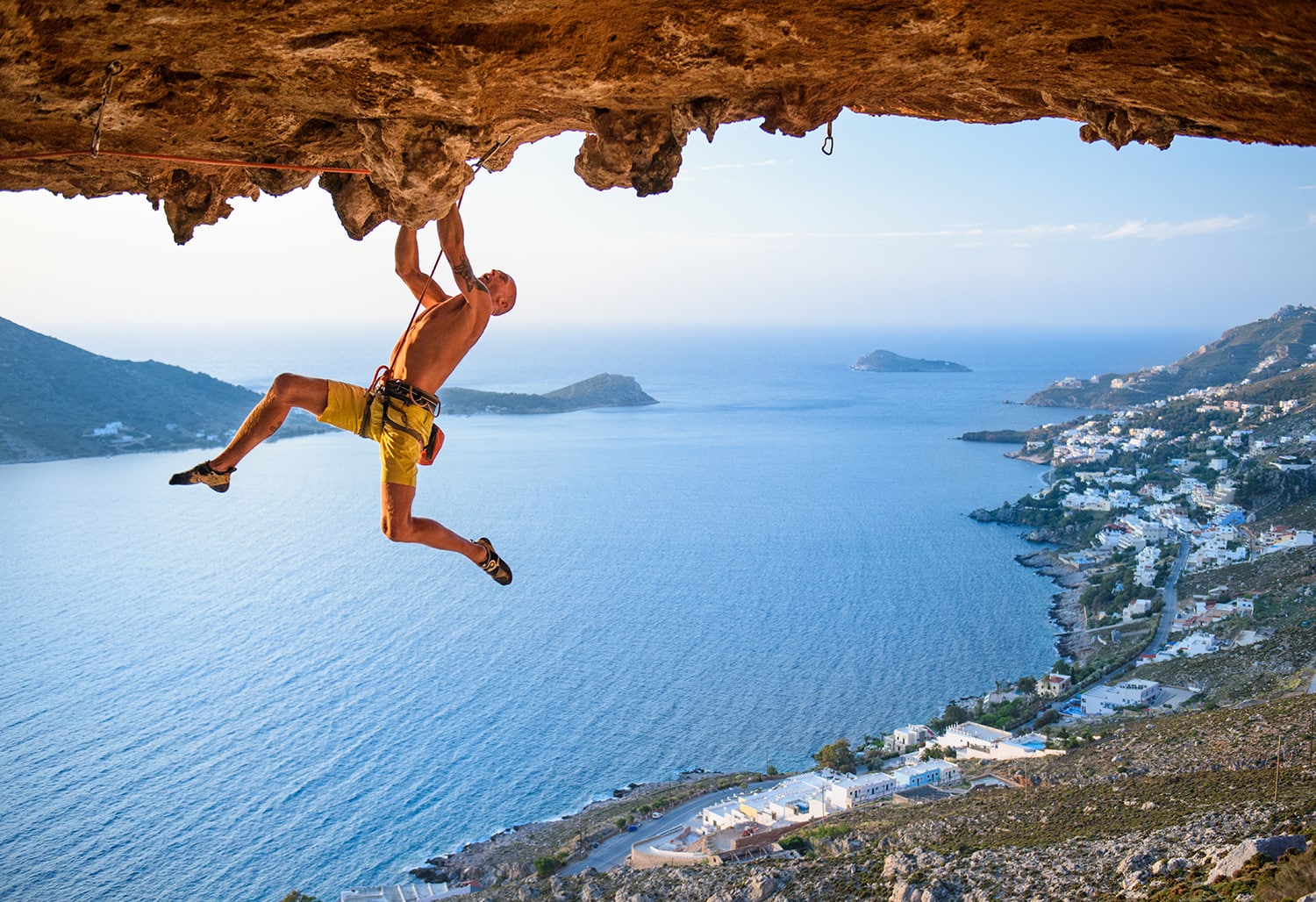
The birthplace of both mountaineering and rock climbing, Europe is home to some of the most incredible rock climbing in the world today, from sport crags to boulderfields to large alpine rock faces holding committing traditional routes.
If you’re a rock climber, taking a trip to Europe at some point in your climbing career is well worth the expense, and not just because there are a plethora of spectacular crags.
Climbing in Europe offers a chance to take a step back in time, testing your mettle against historic climbs that served as stepping stones for our sport. Most of the world’s hardest rock climbs, at one point or another, were located in Europe, including the first 5.13c/8a+, 5.13d/8b, 5.14b/8c, 5.14c/8c+, 5.14d/9a, and every letter grade in the 5.15 range (from 9a+), save for 5.15b/9b (Chris Sharma’s Jumbo Love at Clark Mountain, CA).
Europe Climbing Areas: Our Picks
1. Kalymnos, Greece – Island Sport Climbing Vacation
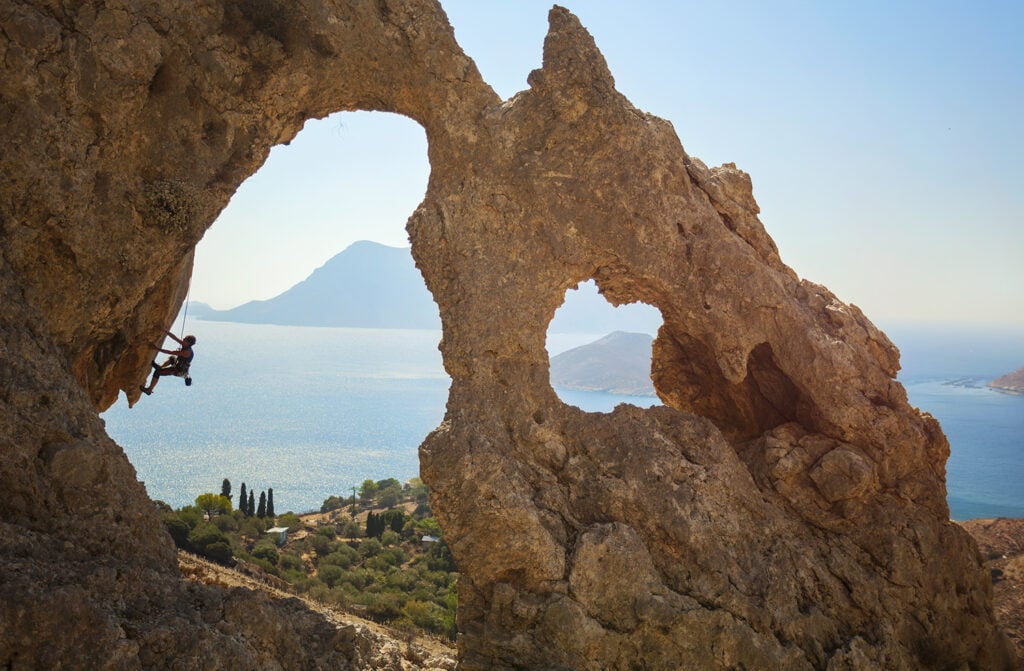
Type of Climbing: Sport
When to Go: Spring to Fall
Rock Type: Limestone
This tiny Greek island off the coast of Turkey isn’t easy to get to. But once you arrive, you’ll be smack dab in the middle of perhaps the highest concentration of intermediate sport climbing anywhere in the world. Though the island is barely 10 miles wide, Kalymnos is home to nearly 3,500 sport routes of all grades. They spread out among 80 crags, something for the experienced & beginner climber alike.
Of course, this is along with spectacular coastal vistas, pristine beaches, and balmy temperatures. Kalymnos’ pristine yellow-orange limestone is famous for overhung lines, chock full of tufas. There are also plenty of knobby slabs and more vertical, techy face routes. Grades range from 5.7/4c to 5.14d/9a, so there’s truly something for every breed of sport climber here.
The best way to get to Kalymnos is to fly into the nearby Greek island of Kos. Then, take a boat out of Mastahari to Kalymnos to the northwest. Most of the best climbing on the island is around the town of Massouri, which can be reached by bus once you arrive. The island can also be reached by boat from Bodrum, Turkey, which is only a dozen miles to the east.
2. Fontainebleau, France – Boulderer’s Paradise
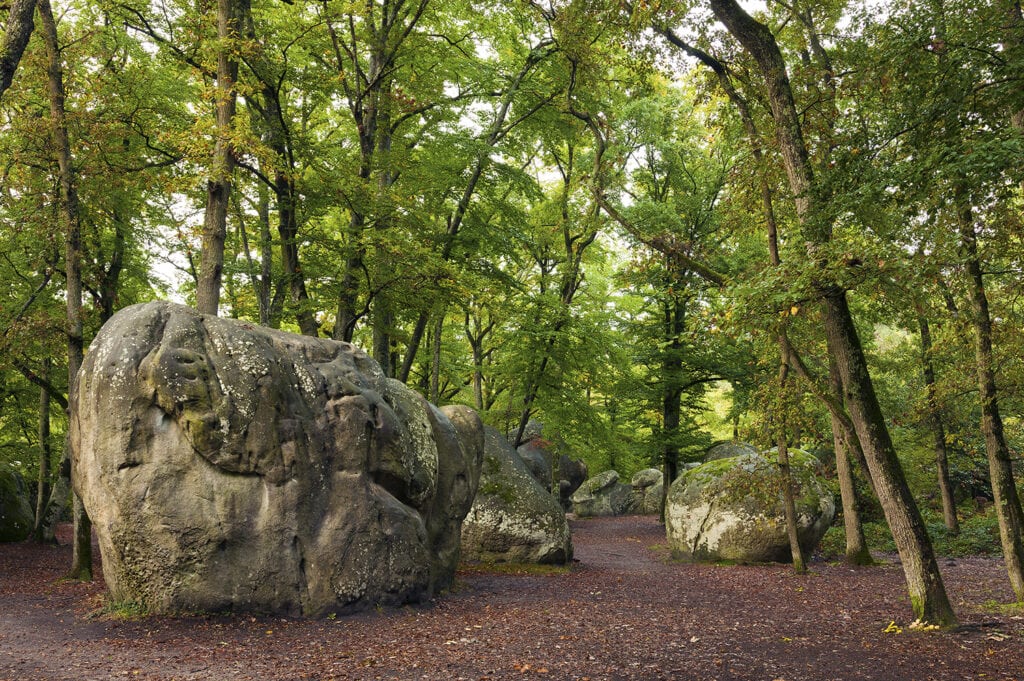
Type of Climbing: Bouldering
Top Season: Summer
Rock Type: Sandstone
Considered one of the birthplaces of modern bouldering (and the origin of the Fontainebleau grading system), a boulder trip to Europe isn’t complete without a stop in “Font” as it’s colloquially known to English speakers.
Tucked away inside shaded forests, the bouldering at Fontainebleau makes for a perfect playground of summer climbing. It’s an escape from the sweltering heat that bakes many other European crags. Fontainebleau is known for short approaches, soft, sandy landings, and a high concentration of climbs in a small area. Nonetheless, the forest still provides relative privacy and seclusion in many spots.

Some of the more popular boulder clusters include Fontainebleau, France, Éléphant, and Cuvier-Chatillon. The latter is perhaps the most iconic (and visited), though there are over 15 different bouldering spots in total, so there are plenty of escapes if the more popular sites are crowded. Climbing at Fontainebleau ranges from V0/4 up to V15/16 (8C/8C+), so there are quite literally routes of all grades here.
Although you’ll find traditional grades, Font problems are also grouped into color-coded circuits based on overall difficulty. In order of easiest to hardest, the colors go White, Yellow, Orange, Green, Blue, Red, and Black. Fontainebleau is a mere 45 miles southeast of Paris, so it’s an easy-access destination. Simply head to the eponymous town, and the rock is spread out in the forest outside.
3. Peak District, United Kingdom – Nail-biting Gritstone Trad Climbing
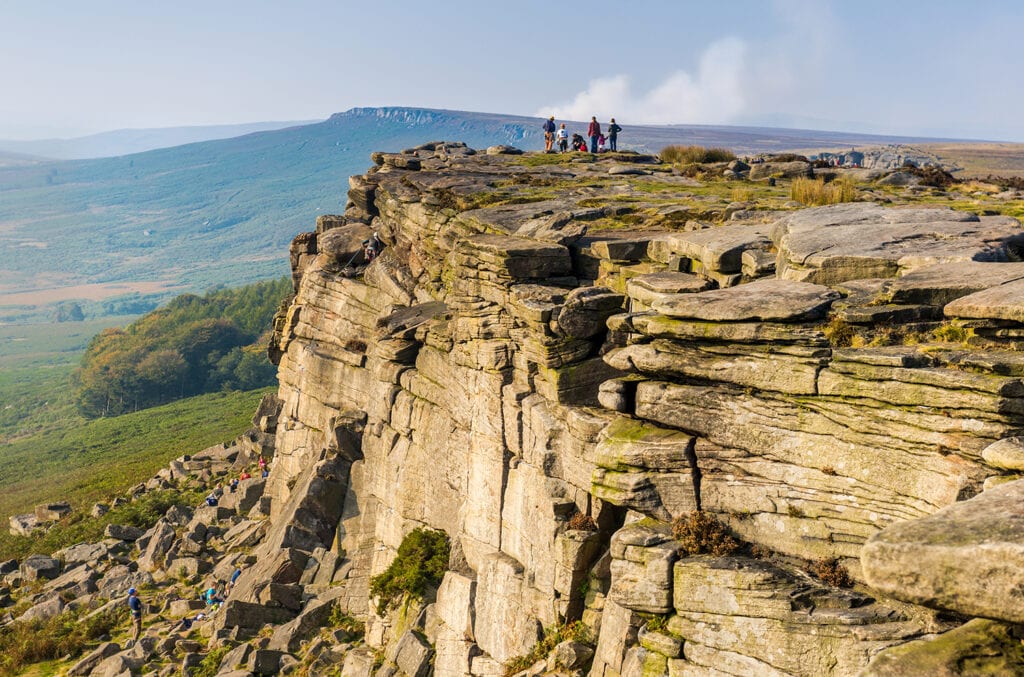
Type of Climbing: Trad & Bouldering
Year Round
Rock Type: Limestone & Gritstone
Smack dab in the middle of central England, tucked between Manchester and Sheffield, is Peak District National Park, one of the best trad climbing areas in the United Kingdom. You’ll find traditional routes ranging from 5.5/4a up to 5.13/7c+, as well as some bouldering. The cliffs there are all quite close together, with quick, easy access. It’s certainly possible to rope up on several different cliffs in a single day.
However, this easy access and proximity to the urban centers of Manchester and Sheffield means that it can get quite crowded. At least on the more popular walls, particularly in the summer months. That said, the best season to climb is spring to fall, but if the rock is dry, it’s quite possible to climb here well into winter (and thus avoid the crowds).
Don’t miss the world-famous Stanage Edge gritstone, where you can test your mettle on Flying Buttress Direct (1) (5.10a PG-13/5c), first sent back in 1966 by Paul Grey and David Johnson. For a mellower variant, try the 5.5/4a Flying Buttress (2). Another must-visit formation in the Peak District is the Unconquerables Buttress (3), home to the Left (5.10-/5c-) and Right (5.9/5b) Unconquerables.
4. Osp, Slovenia – Bolted Lines for Everyone

Type of Climbing: Sport
When to Go: Spring to Fall
Rock Type: Limestone
One of Slovenia’s premiere rock climbing destinations is only a stone’s throw from the Italian border, just across the gulf from Venice and a few miles from the port town of Trieste. Osp, and the neighboring limestone crags of Misja Pec and Crni kal, hold over 600 bolted lines. The area has both multi-pitch and single-pitch routes, all within a couple of miles of each other.
Advanced climbers will find steep walls and overhanging routes at Misja Pec, with mellower grades and inclines at Crni kal. Osp is incredibly easy to access, with many of the climbing routes literally hanging over the eponymous village. Misja Pec is only a few hundred meters away, and Crni Kal approximately three miles.
Given its proximity to climbing areas elsewhere in Italy and Croatia, Osp is the perfect stopover during a climbing Europe trip. Like the Peak District, climbing is possible in Osp all year, though the winter months can be rather cold and wet. Be sure to take a breather to see the beaches, pristine hiking along the coastline, and plethora of historic castles.
5. Dolomites, Italy – Iconic, Committing Climbs
Type of Climbing: Trad & Alpine
When to Climb: Late Spring to Late Fall
Rock Type: Limestone
You’d be hard-pressed to find a climber that hasn’t heard of the Dolomites. These rugged limestone ramparts and spires are home to many of the most storied climbs in the history of the sport, and a visit to the Dolomites is akin to a pilgrimage for many lifelong climbers. The Dolomites are best known for lengthy alpine and trad lines, true adventure climbing.
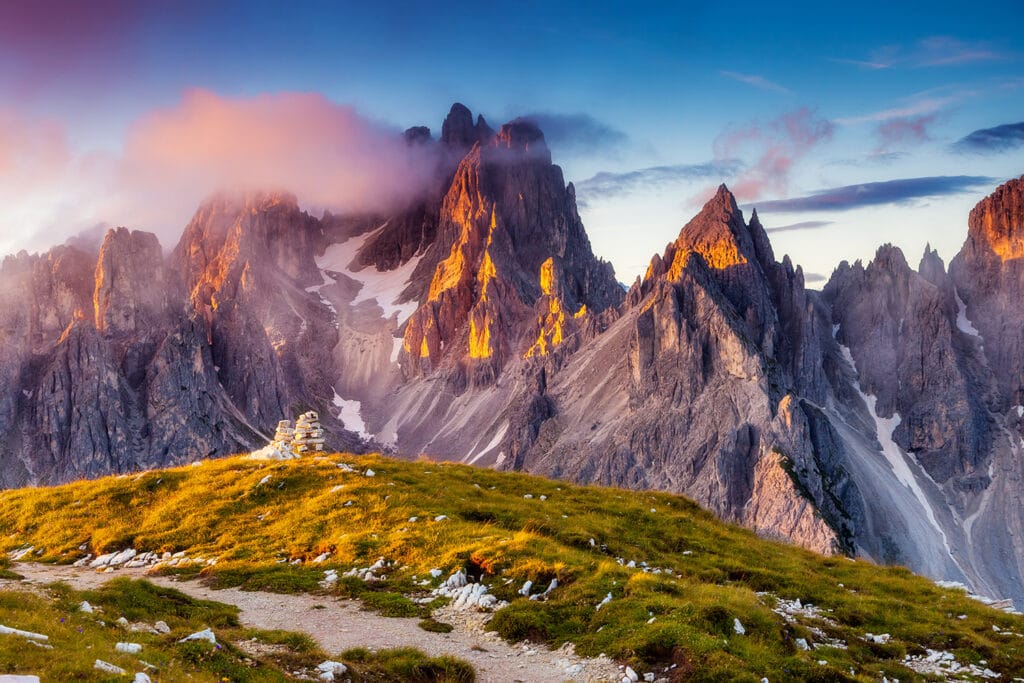
The Dolomites are located in northern Italy, a few hours’ drive from Munich, Innsbruck, and Milan, with Venice being the closest major city. Unlike some other more off-the-beaten-path rock climbing destinations in Europe, the Dolomites has an active Mountain Project page, where you can find info on the area’s classic routes (4).
The Dolomites is more of an adventure destination than the preceding entries on our list. So keep in mind that, depending on the season and route you choose, you may find loose rock and unreliable fixed pro. Be sure to bring your sharpest climbing skills. A piton hammer and a selection of pins are advised if you choose to climb a less-traveled route.
Though routes range from 5.6/4b to 5.13/7c+, the Dolomites is an “old school” destination, so many routes can feel pretty sandbagged. It’s not all free rock climbing. There are many via ferrata routes as well (in fact, the region is considered the birthplace of via ferrata), which makes the Dolomites a great spot for less experienced climbers to get a taste of exposed, committing climbing routes.
6. Céüse, France – Hard, High-Quality Sport Climbing
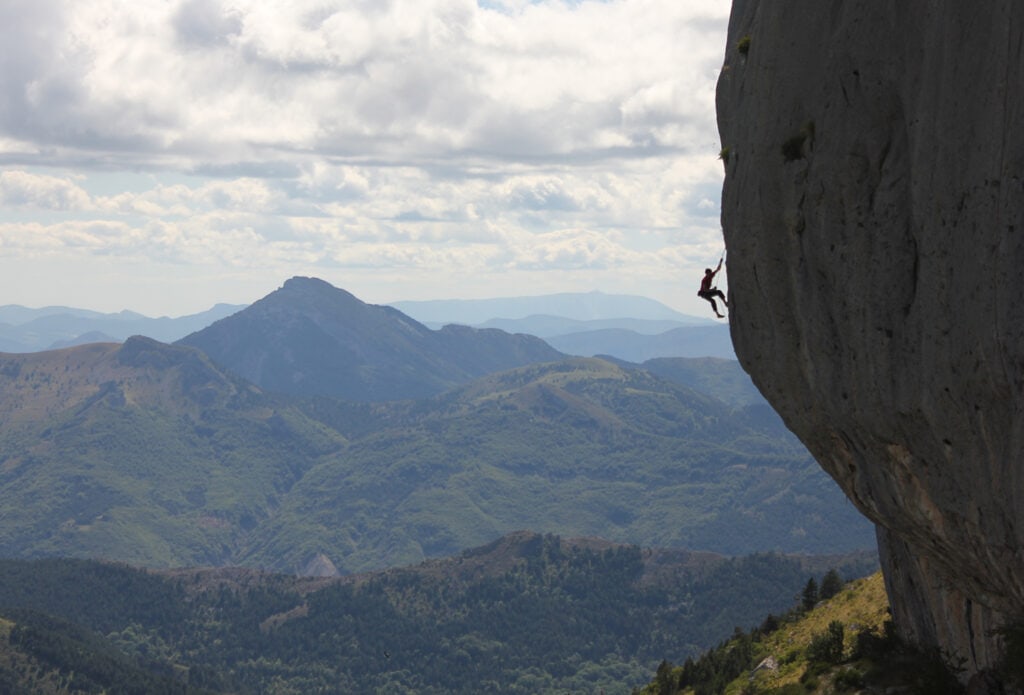
Type of Climbing: Sport
Climbing Season: Spring and Summer
Rock Type: Limestone
It’s hard to beat a climbing holiday on the Mediterranean Sea at Kalymnos. But if your goal is tackling stiffer grades while climbing in Europe, Céüse, France, is worth visiting. There’s a wide variety of techy routes spread along this prominent cliff band, ranging from 5.10/5c up to as hard as your heart (or fingers) desire. The approach is a bit of a hike, but once you get up to the climbing areas, you’ll find dozens of routes arrayed in both directions along an imposing west-east face.
Most climbers gravitate to the near-vertical face of Demi Lune, where you’ll find most of the easier climbs. However, the area tends to get crowded, and there are approximately a dozen different walls, so it’s worth it to climb elsewhere. For harder routes, visit the Berlin or Cascade walls, home to enough crimpy 5.12s (7a+) and 5.13s (7c+) to beat anyone’s fingers halfway to hell.
While not as jam-packed with routes as Kalymnos or Osp, Céüse is a tremendous trove of high-quality climbs for more serious climbers. The crag is accessed by heading to the village of Gap in southeastern France, then heading toward Sigoyer commune at the foot of the cliffs.
7. Siurana, Spain – A Winter Haven for Stiff Sport
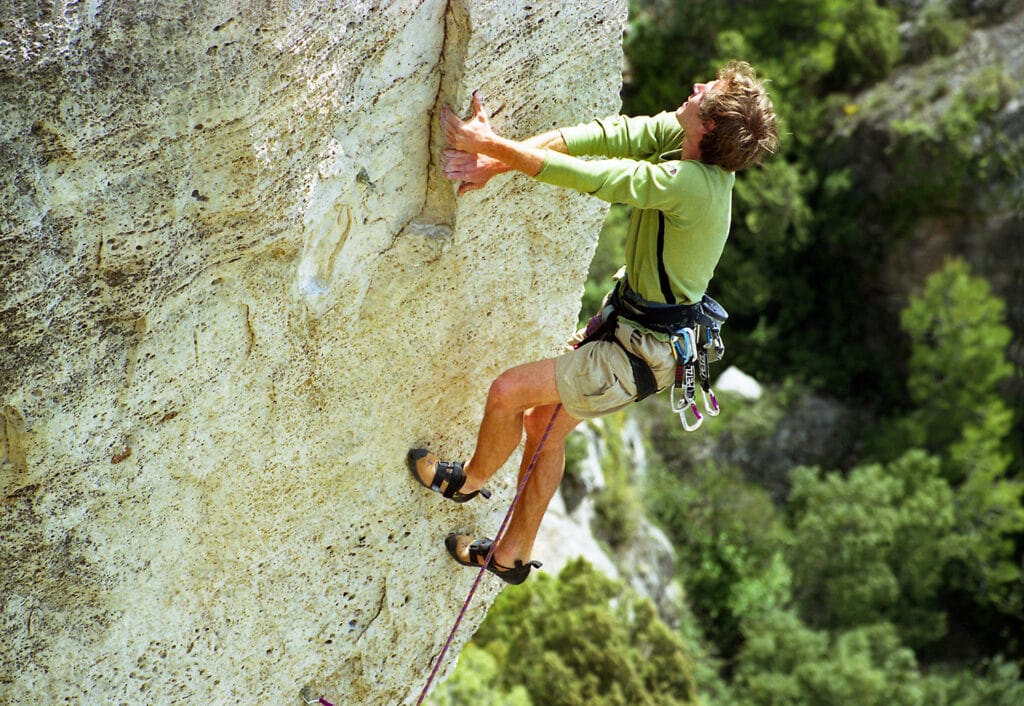
Type of Climbing: Sport
Best Season: Late Fall to Early Spring
Rock Type: Limestone
Another of the many standout sport climbing destinations in Europe, Siurana offers over 1,750 routes of all grades but is known for technical climbing & tough climbs, with sharp, thin crimps and steep walls, most vertical or slightly overhanging.
The northeastern Spanish climbing area is famous as the site where Margo Hayes clipped chains on La Rambla, becoming the first female to send 5.15a/9a+. Despite Siurana’s relative difficulty, Margalef is a short drive away, and unlike many rock climbing crags on this list, it’s a superb winter destination thanks to its southerly cliffs.
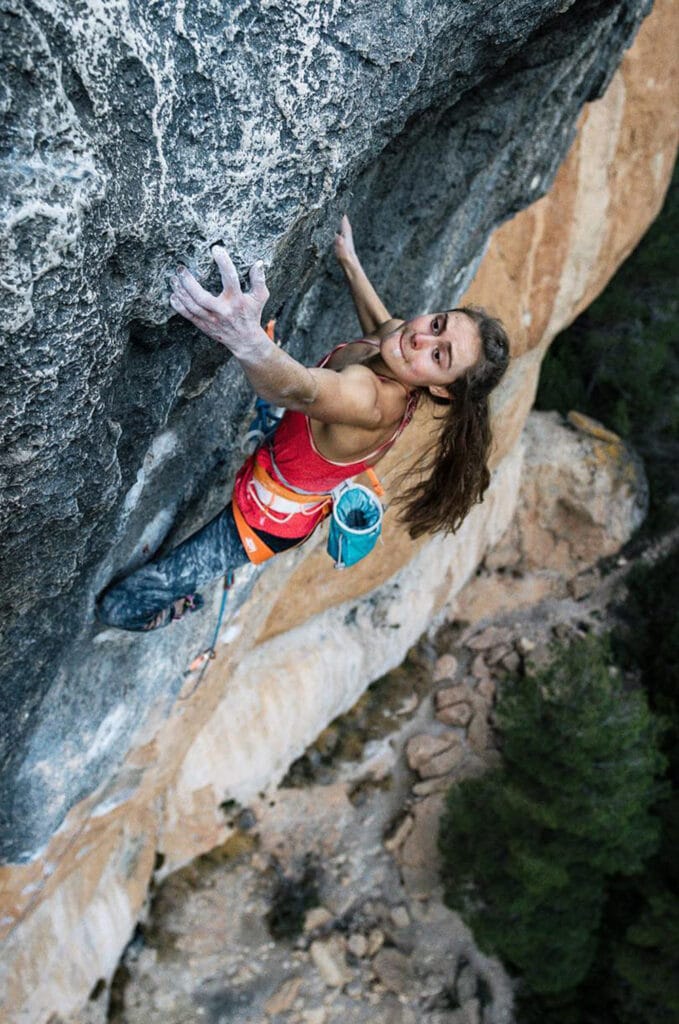
Several limestone cliffs surround the eponymous village, and despite Siurana’s popularity, the secluded nature of each area helps with crowding. It’s easy to get away from it all, even during the more popular months. Siurana is two hours from Barcelona by car.
8. Magic Wood, Switzerland – The Mecca of Alpine Bouldering
Type of Climbing: Bouldering
Top Season: Summer
Rock Type: Gneiss
One of the highest concentrations of hard boulders anywhere in the world, Magic Wood truly is a mecca for hard bouldering in Europe. Approximately 1,000 boulder problems ranging from V3/6A up to V15/8C are tucked away in this small river valley amid mossy hillsides, twisting forest paths, and sprawling roots. The place truly looks plucked straight from a fairy tale!
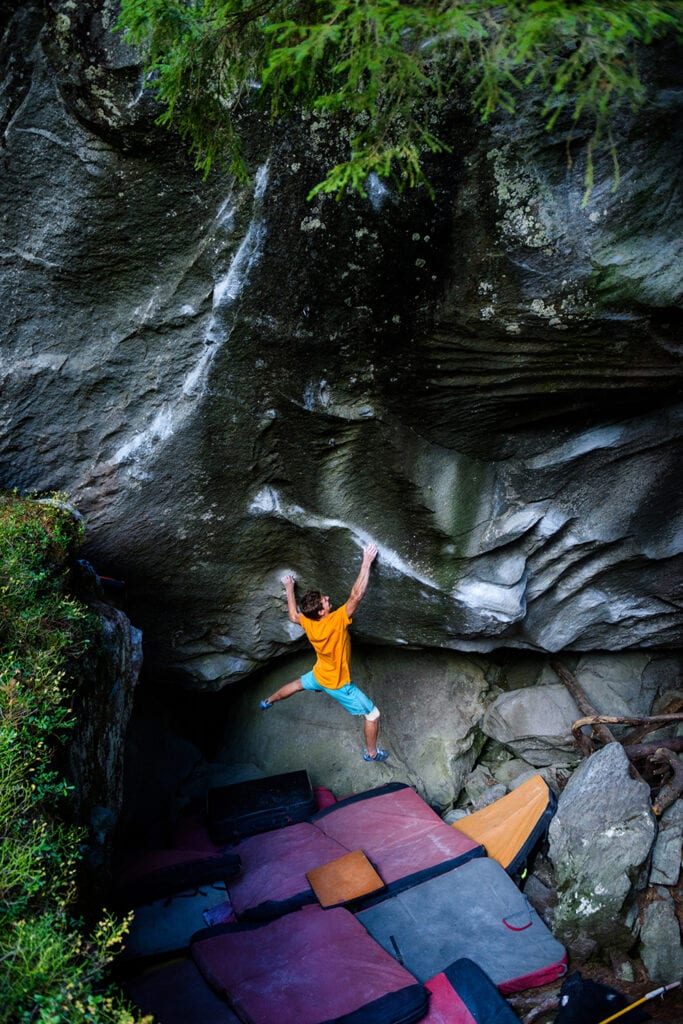
There are plenty of easier problems to climb here, but Magic Wood is known for its hard boulders, and most of the quality problems are on the higher end of the scale. Most routes on the gneiss boulders feature crimps and sketchy, uneven landings, so don’t skimp on pads or spotters. Magic Wood’s alpine elevation and climate make it a spectacular summer bouldering spot when other European crags are too hot, although summer storms aren’t uncommon.
The easiest way to get to Magic Wood for a climbing trip is to fly into Zurich, catch a train to Thusis, and take a bus from there to Andeer. In Andeer, you’ll change buses to Juf and get off at the tiny town of Schmeltzi. Cheap camping is a stone’s throw from the climbing area, where you’ll also find guidebooks and other supplies.
9. Chamonix, France – Peerless Alpine Multi-Pitch
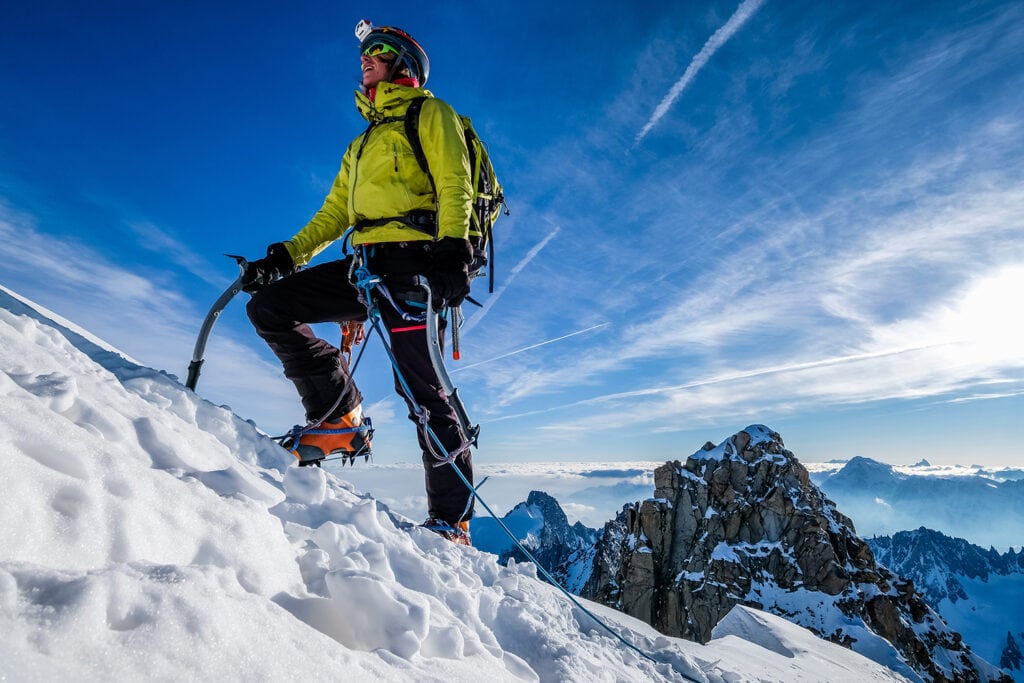
Type of Climbing: Alpine & Trad
Climbing season varies, but early summer is often ideal
Rock Type: Granite
The alpine multi-pitch routes at Chamonix Mont Blanc (“Cham”) are unparalleled, likely the best alpine climbing in Europe. But not only is this French mountain town home to incredible alpine granite cracks. You’ll find routes on snow, ice, and mixed terrain, too, as well as ski mountaineering. Did we mention that the tallest peak in western Europe, Mont Blanc, is within spitting distance?
Chamonix is too vast to begin to talk about in a short entry like this, so I won’t begin to tell you what to do here. Just rest assured that if alpine climbing is your thing, Chamonix is your place. Chamonix isn’t hard to get to and is a tourist destination in its own right, outside of climbing, but the nearest major airport is Geneva, Switzerland. Learn more about Chamonix on Mountain Project (5).
10. Frankenjura, Germany – Jaw-Dropping Array of Sport Routes

Type of Climbing: Sport
Best Season: Late Spring to Fall
Rock Type: Limestone
Located around 25 miles northeast of Nuremberg, the Frankenjura is, without a doubt, among the largest and most famous climbing destinations in Europe and certainly the finest in Germany.
The Bavarian region is home to a whopping 1,000 crags of vertical or overhanging pocketed limestone, all hidden throughout sprawling forests. This single-pitch paradise is home to over 10,000 routes of all grades. The shaded crags make for an excellent summer climbing destination.
The region is home to many of the most famous climbs in the history of rock climbing, such as Wolfgang Güllich’s Action Directe, the world’s first consensus-graded 5.14d/9a. It’s also where the pioneering Kurt Albert invented the term redpoint (“Rokpunkt”), painting a red dot at the beginning of his ticks, starting with Adolf Rott Gedenkweg (5.10a/5c) way back in 1975!
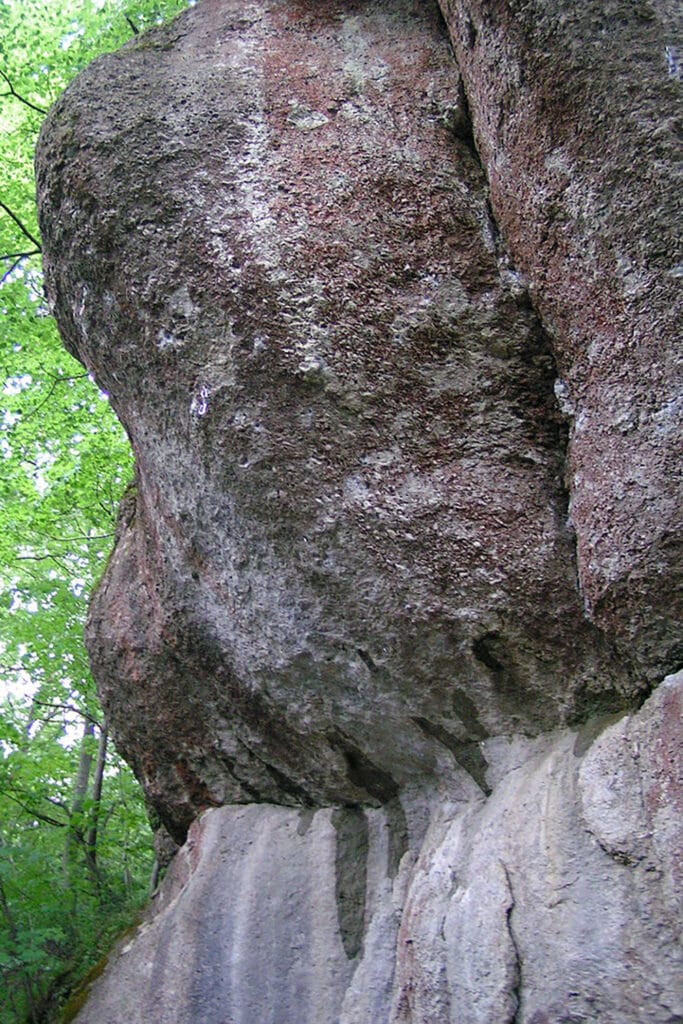
If you want one destination with as much quantity and variety as possible, with a dose of history thrown in, look to the Frankenjura!
11. Mallorca, Spain – Deep Water Solo Rock Climbing
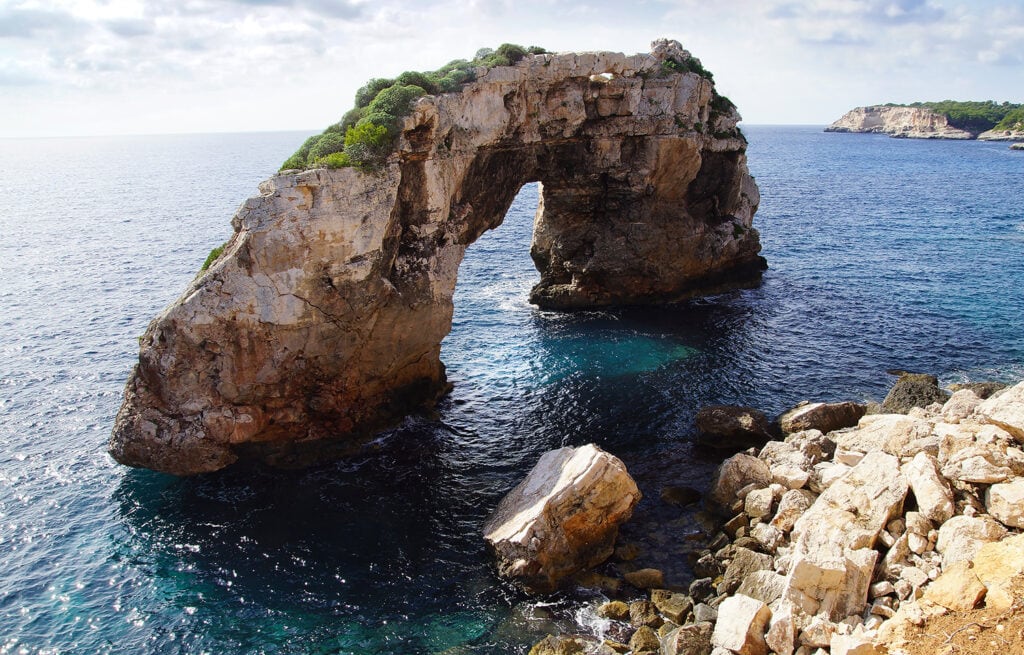
Type of Climbing: Deep Water Solo & Sport
When to Climb: Summer
Rock Type: Limestone
This rocky Spanish island is another heaven for sport climbers (one of the most memorable rock climbing holidays you’ll ever have). But it’s the craggy coastal cliffs that make Mallorca special because they harbor some of the finest deep water soloing anywhere in the world.
There are several crags on all sides of the island, but highlights are the rock bowl at Sa Gubia, the sprawling sea cliffs on the Formentor peninsula, and steep cracks of La Creveta and El Fumat.
Mallorca still houses tons of potential for new DWS routes, and the established climbing is best accessed via local guidebooks, not online, though Mountain Project does list 230 climbs (6) on the island, mostly sport. To get to Mallorca, most climbers fly into the island’s largest city, Palma, but ferries also operate regularly from the mainland.

Keep in mind that deep water soloing is a dangerous discipline, with smashing waves, rockfall, and other obstacles to contend with. This author wrote an obituary last year for two climbers who died while deep water soloing in Spain after being hit by a rockslide.
Psicobloc above a pool and psicobloc above a raging sea cliff are two very different things. Plan to be climbing routes well within your grade, and keep an eye on conditions.
Are you looking for climbing partners/guides in Europe or tips about destinations? Join our Facebook Group (6K members): European Rock Climbing Trips.
References
Flying Buttress Direct (retrieved on 11/28/2022)
https://www.mountainproject.com/route/106092352/flying-buttress-direct
Flying Buttress (retrieved on 11/28/2022)
https://www.mountainproject.com/route/106303979/flying-buttress
Unconquerable Buttress Rock Climbing (retrieved on 11/28/2022)
https://www.mountainproject.com/area/106506941/unconquerable-buttress
Classic Climbs for Dolomites (retrieved on 11/28/2022)
https://www.mountainproject.com/area/classics/105967163/dolomites
Chamonix Mont Blanc Rock Climbing (retrieved on 11/28/2022)
https://www.mountainproject.com/area/106470309/chamonix-mont-blanc
Mallorca Rock Climbing (retrieved on 11/28/2022)
https://www.mountainproject.com/area/106473527/mallorca
